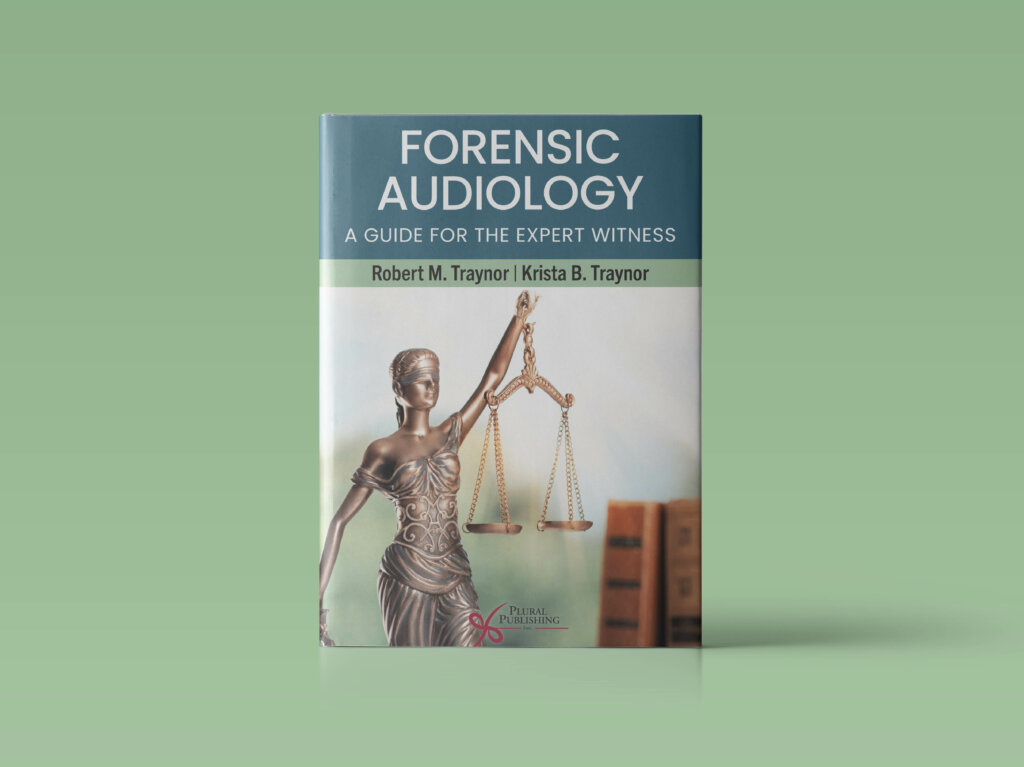Book Review

Forensic Audiology: A Guide for the Expert Witness
Robert M. Traynor and Krista B. Traynor
Plural Publishing, Inc., ISBN # 978-1-63550-411-8, 2024
Reviewed by Marshall Chasin, AuD., Doctor of Audiology
Forensic Audiology, by Robert M. Traynor and Krista B. Traynor is an overview of an expert witness’s roles, responsibilities, and limits for legal proceedings. Among other things it provides a comprehensive overview of this sub-branch of our field.
The Prologue provides the reader with a fascinating overview of the history of the expert witness in the legal and court systems. This extends back to a British court case in 1792 where John Smeaton, a Civil Engineer, provided scientific and engineering information to assist the court in deciding liability for an improperly designed sea-wall.
Chapter 1 entitled “Introduction to Forensic Audiology” begins with a series of possible roles of an expert witness. Unlike building a house where the painters and decorators come in near the end, an expert witness is often retained early on during the preliminaries, and it may be years before a case goes to trial (if it even goes to trial). Some of the roles would be assessing the value of the case, assisting the legal team in the formulation of claims, possible defenses, helping to evaluate damages, reviewing documents, challenging the other side’s expert witnesses, and, of course, providing the court with expert audiology, and scientifically-related knowledge.
Of interest in Chapter 1 is that the normal training and experience of any audiologist would be sufficient to act in the capacity of an expert witness and this underscores the breadth of the field of audiology and audiological expertise in general. Personally, I have been involved as an expert witness on 8 occasions, and each time I only needed to use what I knew as an audiologist. While I am a Canadian audiologist, 5 of the 8 cases were in the United States, leading us to Traynor and Traynor’s second and third chapters.
Chapters 2 and 3 are “American” in content but the rules and regulations are similar in all Western countries. While the Canadian court system may differ subtly from the American system (which can even vary from state to state), the principles of evidence and requirements are similar. This book provides a nice overview of what to expect and why these steps are common to most countries.
Chapters 4 and 5 provide us with the structure and elements of both criminal (Chapter 4) and civil (Chapter 5) cases. Again, there are some differences between the Canadian and American court systems, but the principles are the same. Definitions may differ slightly, and the order of any proceedings may vary somewhat, but these are legal issues, not audiological ones. It is important for the expert audiology witness to know what is happening behind all of the paperwork and motions, but doesn’t need to know the details. However, having said this, these structural chapters were very enlightening and provided a backroom glimpse into the workings of our legal systems.
Chapters 6 and 7 are also “structural” chapters that discuss the various steps but concentrate on what the expert audiology witness is required to do. This begins with an expert report, which is rarely done in a vacuum. More often than not, significant legal direction is provided to the expert audiology witness, and the report may only be a working document. With input from the legal team, certain sections may be moved based on relevance or entire sections may be rewritten. This is one of the most important documents an expert audiology witness will provide. It is pointed out that there needs to be a difference between scientific knowledge and advocacy. While advocacy can be important, it has no place in the legal system. This is especially the case during any deposition since this will be used during the legal proceedings.
This brings us to the book’s final part (Chapter 9), which deals with the ethics of expert witnesses. This chapter deals with conflicts of interest and overstates conclusions that the data and agreed-upon facts may not support. The following three Appendices deal with the American code of ethics from the American Speech-Language-Hearing Association Code of Ethics (2023); the American Academy of Audiology Code of Ethics (2023); and the Academy of Doctors of Audiology Code of Ethics (2023). Together, these are similar to those found federally (e.g., Canadian Academy of Audiology) or provincially (typically by regulatory Colleges) in Canada.
In short, Forensic Audiology, a 354-page book, covers every element that any audiologist needs to know about if they become an expert audiology witness in Canada and other countries. I would highly recommend this book, not only to learn about Forensic Audiology, but also to remind us how broad and encompassing our profession is.

